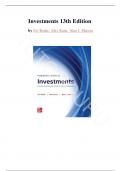uytrewsa
Investments 13th Edition
by Zvi Bodie, Alex Kane, Alan J. Marcus
TU
TO
R
G
U
R
U
wertyui
, uytrewsa
CHAPTER 1: THE INVESTMENT ENVIRONMENT
PROBLEM SETS
1. Ultimately, it is true that real assets determine the material well-being of an economy.
Nevertheless, individuals can benefit when financial engineering creates new products that
allow them to manage their portfolios of financial assets more efficiently. Because
bundling and unbundling creates financial products with new properties and sensitivities
TU
to various sources of risk, it allows investors to hedge particular sources of risk more
efficiently.
2. Securitization requires access to a large number of potential investors. To attract these
investors, the capital market needs:
(1) a safe system of business laws and low probability of confiscatory
TO
taxation/regulation;
(2) a well-developed investment banking industry;
(3) a well-developed system of brokerage and financial transactions, and;
(4) well-developed media, particularly financial reporting.
These characteristics are found in (indeed make for) a well-developed financial market.
R
3. Securitization leads to disintermediation; that is, securitization provides a means for
market participants to bypass intermediaries. For example, mortgage-backed securities
G
channel funds to the housing market without requiring that banks or thrift institutions
make loans from their own portfolios. As securitization progresses, financial
intermediaries must increase other activities such as providing short-term liquidity to
consumers and small business, and financial services.
U
4. Financial assets make it easy for large firms to raise the capital needed to finance their
investments in real assets. If General Motors, for example, could not issue stocks or
R
bonds to the general public, it would have a far more difficult time raising capital.
Contraction of the supply of financial assets would make financing more difficult,
thereby increasing the cost of capital. A higher cost of capital results in less investment
U
and lower real growth.
wertyui
, uytrewsa
5. Even if the firm does not need to issue stock in any particular year, the stock market is still
important to the financial manager. The stock price provides important information about
how the market values the firm's investment projects. For example, if the stock price rises
considerably, managers might conclude that the market believes the firm's future prospects
are bright. This might be a useful signal to the firm to proceed with an investment such as
an expansion of the firm's business.
In addition, the fact that shares can be traded in the secondary market makes the shares
more attractive to investors since investors know that, when they wish to, they will be able
to sell their shares. This in turn makes investors more willing to buy shares in a primary
offering, and thus improves the terms on which firms can raise money in the equity market.
TU
6. a. Cash is a financial asset because it is the liability of the federal government.
b. No. The cash does not directly add to the productive capacity of the economy.
c. Yes.
TO
d. Society as a whole is worse off, since taxpayers, as a group will make up for the
liability.
7. a. The bank loan is a financial liability for Lanni. (Lanni's IOU is the bank's financial
asset.) The cash Lanni receives is a financial asset. The new financial asset created
R
is Lanni's promissory note (that is, Lanni’s IOU to the bank).
b. Lanni transfers financial assets (cash) to the software developers. In return, Lanni
G
gets a real asset, the completed software. No financial assets are created or
destroyed; cash is simply transferred from one party to another.
c. Lanni gives the real asset (the software) to Microsoft in exchange for a financial
U
asset, 1,500 shares of Microsoft stock. If Microsoft issues new shares in order to pay
Lanni, then this would represent the creation of new financial assets.
d. Lanni exchanges one financial asset (1,500 shares of stock) for another ($120,000).
R
Lanni gives a financial asset ($50,000 cash) to the bank and gets back another
financial asset (its IOU). The loan is "destroyed" in the transaction, since it is retired
when paid off and no longer exists.
U
wertyui
, uytrewsa
8. a.
Liabilities &
Assets
Shareholders’ equity
Cash $ 70,000 Bank loan $ 50,000
Computers 30,000 Shareholders’ equity 50,000
Total $100,000 Total $100,000
Ratio of real assets to total assets = $30,000/$100,000 = 0.30
b.
Liabilities &
Assets
TU
Shareholders’ equity
Software product* $ 70,000 Bank loan $ 50,000
Computers 30,000 Shareholders’ equity 50,000
Total $100,000 Total $100,000
*Valued at cost
Ratio of real assets to total assets = $100,000/$100,000 = 1.0
TO
c.
Liabilities &
Assets
Shareholders’ equity
Microsoft shares $120,000 Bank loan $ 50,000
Computers 30,000 Shareholders’ equity 100,000
Total $150,000 Total $150,000
R
Ratio of real assets to total assets = $30,000/$150,000 = 0.20
Conclusion: when the firm starts up and raises working capital, it is characterized by
G
a low ratio of real assets to total assets. When it is in full production, it has a high
ratio of real assets to total assets. When the project "shuts down" and the firm sells it
off for cash, financial assets once again replace real assets.
U
9. For commercial banks, the ratio is: $107.5/$10,410.9 = 0.010
For non-financial firms, the ratio is: $13,295/$25,164 = 0.528
R
The difference should be expected primarily because the bulk of the business of
financial institutions is to make loans; which are financial assets for financial
institutions.
U
10. a. Primary-market transaction
b. Derivative assets
c. Investors who wish to hold gold without the complication and cost of physical
storage.
wertyui





